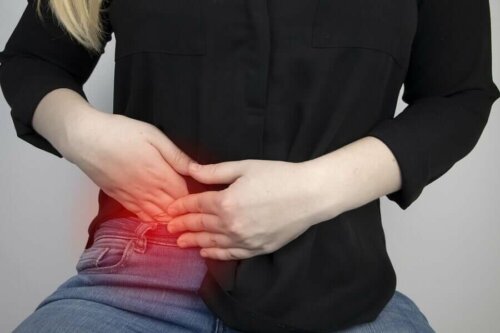Symptoms of Appendicitis You Should Know About


Reviewed and approved by the doctor José Gerardo Rosciano Paganelli
Many people are urgently operated on when they have acute appendicitis, thus being a medical emergency that you should always know the symptoms of and be alert.
Acute appendicitis is basically due to an inflammation of the appendix. It can occur in children and adults, so it’s not something that can only occur during childhood or adolescence.
Next, we want to show you some of the symptoms that’ll give you clues about if you’re suffering from acute appendicitis and that you should see a doctor as soon as possible. Don’t miss them!
Symptoms of appendicitis

1. The type of pain
- This type of pain usually occurs in the lower right of the abdomen. It often varies in intensity. However, in many cases, the first sign of pain is felt near the belly button and even lower back.
- This symptom tends to get worse when you when you apply pressure to this area.
- Your abdomen is somewhat hard. If you have a strange feeling of “fullness”, just press your abdomen a little and you’ll immediately notice an unusual firmness and hardness.
- It’s very possible that, while walking, this pain at the height of the hip and is more incisive and stabbing. Remember that it’s always on the right side.
- The only time you’ll feel relief is when you lie on the right side. When you lie down, that discomfort goes away.
- Try coughing. If when doing so you notice a great pain or burning in the abdomen, it’s a clear sign that you have an inflammation in this area of the abdomen.
- Bear in mind that, if you feel any of these symptoms, it’s very likely that between 12 and 24 hours later they will become more acute and you’ll need to go to the emergency room.
Read about What is Appendicitis and What Causes It?
2. Other symptoms
- Fever. It’s very important, that as soon as this discomfort on the right side is accompanied by a fever, go to the doctor immediately.
- Constipation. This infection can translate into small intestinal disorders. It’s very common to suffer periods of constipation, it’s even very possible that while making an “effort”, a strong pain emerges immediately.
- Loss of appetite. We feel a very uncomfortable feeling of fullness. It’s enough to eat very little to feel full.
- Vomiting, nausea, and tiredness also often accompany symptoms of appendicitis. They’re signs that can appear even a few days before the pain becomes already unbearable.
Symptoms and causes of appendicitis

1. Hyperplasia of lymphoid follicles
The name is complicated, but it’s easy to understand. It’s something very similar to what happens with our tonsils in the pharynx. They’re elements that have their important function in the appendix, but when they become inflamed, they grow and become obstructed, which causes an infection or fever.
This infection usually affects people between the ages of 8 and 30, hence it’s more common to suffer appendicitis at these ages.
2. Fecal waste
Sometimes this part of the intestine ends up accumulating too much waste from the fecal process. Hence it becomes clogged and infected. As a result, the good blood supply to the appendix ceases and an obstruction occurs.
It should be taken into account that suffering from very continuous periods of constipation puts us in this same danger. Little by little the intestine becomes “lazy”, causing inflammations, infections.
3. Inflammation

The walls of the appendix are lined with small elements called lymphoid follicles. Sometimes a disease or outside elements cause bacteria to adhere to them and infect them. It’s something very common.
Therefore, it’s important to take good care of your diet. By this, we’re not saying you’ll definitely avoid suffering from appendicitis, but you can probably prevent it.
In fact, a study published in the International Journal of Food Sciences and Nutrition revealed that a diet low in fiber increases the chances of appendicitis in children.
Therefore, drink plenty of fluids, consume fiber, vegetables, and fresh fruit, without overlooking the excellent benefits of probiotics. Foods such as kefir or Greek yogurt have very suitable properties to provide us with good bacteria capable of protecting us.
It’s important to help your body cleanse itself and avoid constipation for our health in general and for appendicitis in particular.
What to do if you have symptoms of appendicitis
If your symptoms coincide with those we’ve mentioned, don’t hesitate, go to the doctor. Otherwise, you could suffer complications, such as a perforated appendix.
The most common way to treat this problem is with surgery. There are various procedures to remove the appendix. It’ll be your doctor who determines which is the most appropriate for your specific case.
It may seem like a complicated procedure, but it’s been done for a long time and is usually relatively uncomplicated.
After the operation, you’ll see how your life improves and those horrible discomforts come to an end. Of course, remember that you should rest and always follow your doctor’s advice.
Also, remember to follow a balanced diet, rich in fiber. This is very beneficial for your digestive health and, therefore, also for your body.
All cited sources were thoroughly reviewed by our team to ensure their quality, reliability, currency, and validity. The bibliography of this article was considered reliable and of academic or scientific accuracy.
- Diagnóstico de la apendicitis. (n.d.). Retrieved November 21, 2018, from https://www.webconsultas.com/apendicitis/diagnostico-de-la-apendicitis-405
- Clasificación del dolor. (n.d.). Retrieved November 21, 2018, from https://www.dolor.com/clasificacion-dolor.html
- Apendice, apendicitis, apendicectomía. (2003). Acta Médica Costarricense, 45(5). Retrieved from http://www.scielo.sa.cr/scielo.php?script=sci_arttext&pid=S0001-60022003000200003
- Apendicitis. (n.d.). Retrieved from https://medlineplus.gov/spanish/appendicitis.html
This text is provided for informational purposes only and does not replace consultation with a professional. If in doubt, consult your specialist.








